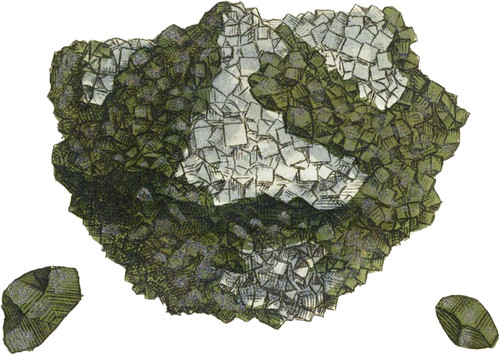 Enlarge
Enlarge
British Mineralogy
Sulphuret of Iron—Iron Pyrites
- Div. 1. Crystallized.
Plates 366 and 367 are curious examples of the crystallization of this substance. The present extraordinary specimen seems to elucidate somewhat of the origin of those modifications from the cube. See the rigid hand lower figure. Two of the horizontal edges at each end of the cube are replaced by rounding faces of such extent that they meet each other in a line, towards which the vertical faces are enlarged at the same time that they become concave (see the right hand figure): three of these crystals are grouped together to form the left hand figure, thus disguising the cubic structure. These and various other intermediate forms, depending upon such a process, are on the specimen, that is to say, one independent crystal, another notched, or one joined as it were by one of its concave sides to another or two others, not more, with the mutual loss to each of a concave face, forming a straight seam, while the other sides are more or less concave or straight, same as represented in the figure, with the striae of aggregation on the upper part, as I shall call it for distinction sake; the whole appearing as if formed from a centre into three wedges. The crystals on this specimen are remarkable for their thickness, which much facilitates the study of them: as they become thinner, they generally group in greater numbers and with less regularity, thus forming the Cock’scomb Pyrites above referred to in tab. 366. The crystals are much elongated, and some of them are joined by their convex faces, forming deeply furrowed groups, not notched plates.
The gangue of this specimen is octaëdral Galæna coated by Cubic Fluor.

